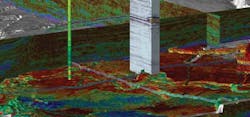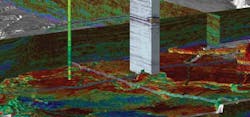Quantitative interpretation emerges as major geoscience tool
Indy Chakrabarti
Paradigm
The rise ofdeepwater exploration, together with the onshore shale boom, has altered many industry geoscience workflows. Organizations are racing to understand how to economically produce these costly modern reservoirs. For interpreters, this has meant the widespread adoption of a series of advanced workflows that are commonly defined as Quantitative Interpretation (QI). Broadly speaking, these techniques take the interpreter beyond delineating reservoir geometry, picking horizons and faults, and defining stratigraphy. The focus of QI is to understand the internals of the reservoir rather than its architecture.
In the quantitative interpretation workflow, the interpreter attempts to characterize the rock type, fluid composition, and flow characteristics of the reservoir. A range of techniques can be employed, from amplitude variation with offset (AVO) analysis and inversion, to facies classification, pore pressure prediction, 4D (time-lapse) seismic analysis, and geomechanical analysis.
AVO is the leading seismic amplitude analysis technology for direct hydrocarbon detection. The workflow requires expertise in many disciplines, as well as the integration of seismic, petrophysical, interpretation, and other forms of data.
Inversion uses well log properties and seismic data to convert the acoustic reflections at layer interfaces into rock properties.
Facies analysis, whether electrofacies using well log data or seismic facies analysis, identifies similar groupings of data, allowing interpreters to identify subtle features.
Understanding pore pressure is important in deep prospects. Pore pressure predictions can be made based on seismic velocities and calibrated to well information. Seismic velocities can be better defined with a 3D model that includes the major structures and major stratigraphic elements.
Time-lapse (4D) seismic analysis can qualify the predictability and repeatability of 4D data prior to running an adapted reservoir characterization workflow at the reservoir level, to confidently analyze and understand the impact of production and injection, and interpret changes in reservoir conditions.
Geomechanical analysis helps understand the distribution of stress within the reservoir and can be critical to reducing drilling risk and superior reservoir management.
The end results of this analysis include a more precise definition of lithology, porosity, estimation of oil and gas in place, brittleness, fracture orientation, and intensity. These results allow operators to make better drilling decisions by identifying the most productive parts of the reservoir.
One driver behind the enhanced interest in quantitative interpretation is the advancement in higher resolution imaging made possible by broadband acquisition and processing. Full azimuth and broad frequency range acquisitions allow operators to see finer features more clearly. New processing techniques like 5D regularization have reduced acquisition limitations at the surface, deghosting and other noise suppression algorithms have improved signal quality, and advanced migration algorithms such as reverse time migration or the proprietary Paradigm full-azimuth angle domain migration (GeoDepth EarthStudy 360), are able to better image complex geology such as near salt flanks. All of these changes mean interpreters can delve much deeper into their data.
However, generalist interpreters still face challenges in incorporating QI analysis into their workflows. Chief among these is the ever present difficulty of data management. Quantitative analysis requires both the integration of well log data with the seismic – both pre- and post-stack – and then share this information with well planning and drilling applications. Ideally, it should be possible to update these quantitative geological models with data received in real time during drilling, and match model data with actual findings. However, most organizations lack integrated software and processes to make this a reality. Often, different parts of the quantitative analysis workflow are conducted in disparate, disconnected tools. This concern has been voiced to Paradigm by customers as the top challenge – how to take advanced workflows and make them available to every user in a single integrated solution. Paradigm believes its forthcoming Epic software is an approach that can help solve this market need.
Despite these challenges, the industry continues to forge ahead, adopting advanced QI workflows in order to reduce the risk on their billion-dollarfield development projects. Experienced interpreters have seen numerous fads come and go, but if the recent years of increasing interest and usage are any indication, quantitative interpretation is here to stay.

